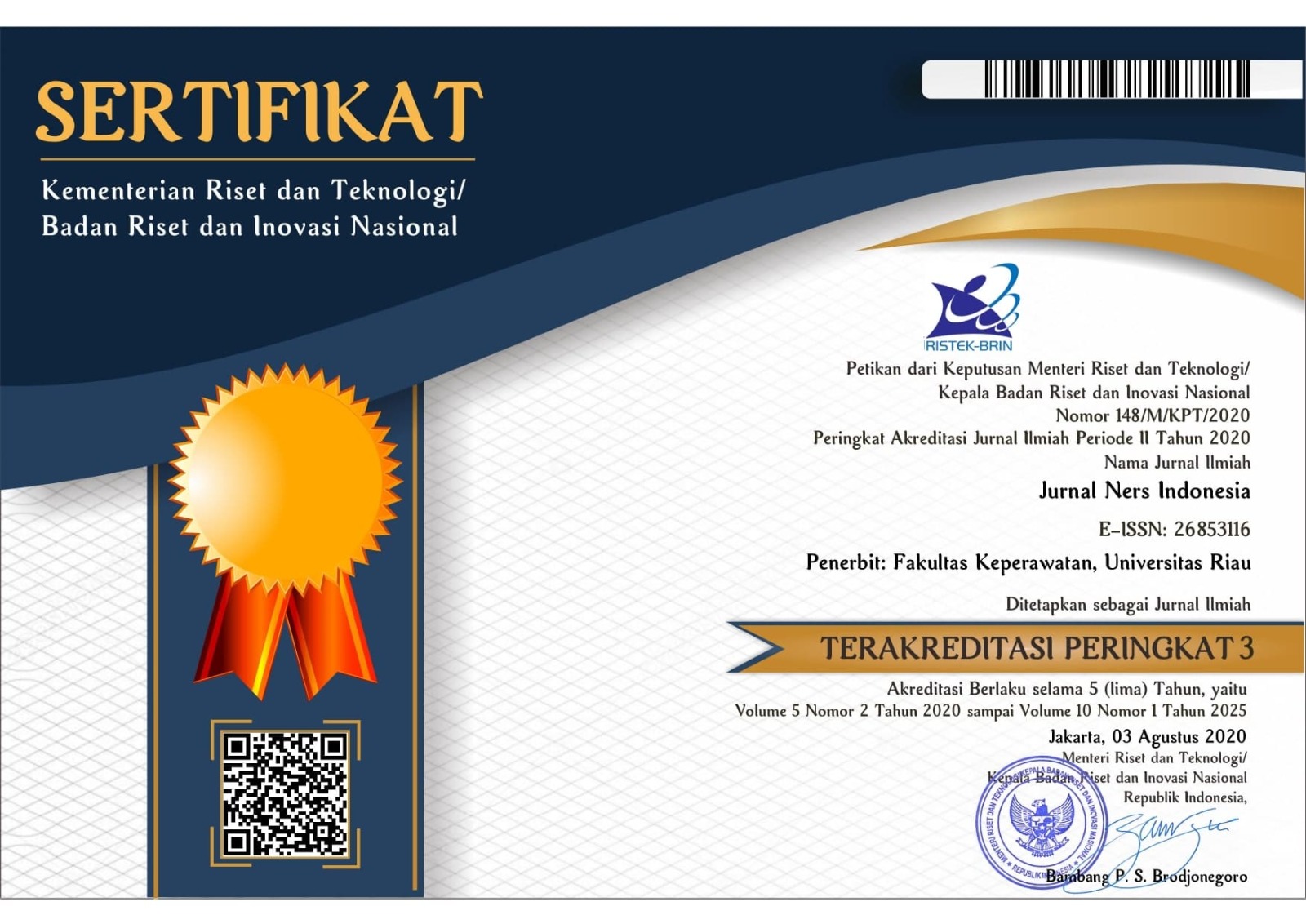GAMBARAN RISIKO DAN UPAYA PENCEGAHAN STUNTING PADA PERIODE KEHAMILAN DIDAERAH ALIRAN SUNGAI
DOI:
https://doi.org/10.31258/jni.13.2.115-127Keywords:
Selama kehamilan, Pencegahan, Risiko stuntingAbstract
Pre-conception and conception were critical period of growth and development of fetus in utero. Restricted intrauterine growth is at great risk of remaining stunted. This study aimed to determine the risk factors of stunting and behavioral factors of pregnant women during pregnancy in the Siak River. Method: the research design used was a convergent parallel design or concurrent mixed methods. A total of 100 respondents of pregnant women as respondents were taken by purposive sampling and 15 participants. A questionnaire, question tools, and environmental observation checklists were used to collect data. A descriptive survey and thematic analysis were selected to identify the predictors and factors associated preventing stunting during pregnancy. Result: the majority of respondents were aged 20-35 years (83%), the level of education was senior high school (63%), a housewife (89%), Minang tribe (40%), Muslim (95%), and had height > 145 cm (99%). The description of the risk factors for stunting in the pregnancy period was respondent who has a height of ≤ 145 cm (1%) and an income of < regional minimum wage of Rp. 3.049.675 (66%). Based on pregnancy characteristics, the majority of respondents were multipara (74%), second-trimester gestational age (57%), and pregnant women who did not do Tetanus Toxoid immunization (76%). Of 31% of pregnant women had antenatal care about two times, and the check-up locations were in Private Practice Midwives (45%) and Public Health Center (40%). The majority of respondents did not have a history of infection (85%), but as many as 15% had a history of the disease (hypertension 7%, Asthma and heart 3%, lung and hypertension plus diabetes mellitus (1%). Most pregnant women do a Hb test (52%), of these figures it was found that 45% have normal Hb levels, moderate anemia was 4% and mild anemia 3%. Furthermore, as many as 88% of respondents did not have dietary habits, and found that as many as 88% of pregnant women consumed Fe tablets (83%), and only 17% did not consume them. Based on the deep interview, participants do healthy lifestyles such as consuming nutritious food, exercising, resting, and checking pregnancy. Furthermore, as many as 74% have high knowledge about stunting prevention efforts during pregnancy. Based on environmental observations, 85% of the home environment was clean, but respondents were in a smoker's environment (74%). All participants (15 people) stated that stunting is a condition of malnutrition in children, having less height, failing to grow or stunted growth, imperfect growth, and mothers with malnutrition that affect children. Women-empowerment and improving health care system are critical to mitigate stunting in children.
Keywords: During pregnancy, prevention, risks of stunting
References
Beal, T., Tumilowicz, A., Sutrisna, A., Izwardy, D., & Neufeld, L. M. (2018a). A review of child stunting determinants in Indonesia. Maternal & Child Nutrition, 14(4), e12617. https://doi.org/10.1111/mcn.12617
Black, R. E., & Heidkamp, R. (2018). Causes of Stunting and Preventive Dietary Interventions in Pregnancy and Early Childhood (pp. 105–113). https://doi.org/10.1159/000486496
Chaveepojnkamjorn, W., Songroop, S., Satitvipawee, P., Pitikultang, S., & Thiengwiboonwong, S. (2022). Effect of Low Birth Weight on Child Stunting among Adolescent Mothers. Open Journal of Social Sciences, 10(11), 177–191. https://doi.org/10.4236/jss.2022.1011013
da Silva Lopes, K., Yamaji, N., Rahman, Md. O., Suto, M., Takemoto, Y., Garcia-Casal, M. N., & Ota, E. (2021). Nutrition-specific interventions for preventing and controlling anaemia throughout the life cycle: an overview of systematic reviews. Cochrane Database of Systematic Reviews, 2022(1). https://doi.org/10.1002/14651858.CD013092.pub2
Delcroix-Gomez, C., Delcroix, M.-H., Jamee, A., Gauthier, T., Marquet, P., & Aubard, Y. (2022). Fetal growth restriction, low birth weight, and preterm birth: Effects of active or passive smoking evaluated by maternal expired CO at delivery, impacts of cessation at different trimesters. Tobacco Induced Diseases, 20(August), 1–15. https://doi.org/10.18332/tid/152111
Desyibelew, H. D., & Dadi, A. F. (2019). Burden and determinants of malnutrition among pregnant women in Africa: A systematic review and meta-analysis. PLOS ONE, 14(9), e0221712. https://doi.org/10.1371/journal.pone.0221712
Dulęba, M., & Kozakiewicz, B. (2022). Cotinine as an indicator of fetal exposure to active and passive smoking in pregnant women. Postępy Higieny i Medycyny Doświadczalnej, 76(1), 358–368. https://doi.org/10.2478/ahem-2022-0037
Ekayanthi, N. W. D., & Suryani, P. (2019). Edukasi Gizi pada Ibu Hamil Mencegah Stunting pada Kelas Ibu Hamil. Jurnal Kesehatan, 10(3), 312. https://doi.org/10.26630/jk.v10i3.1389
Fadare, O., Amare, M., Mavrotas, G., Akerele, D., & Ogunniyi, A. (2019). Mother’s nutrition-related knowledge and child nutrition outcomes: Empirical evidence from Nigeria. PLOS ONE, 14(2), e0212775. https://doi.org/10.1371/journal.pone.0212775
Fikadu, T., Assegid, S., & Dube, L. (2014). Factors associated with stunting among children of age 24 to 59 months in Meskan district, Gurage Zone, South Ethiopia: a case-control study. BMC Public Health, 14(1), 800. https://doi.org/10.1186/1471-2458-14-800
Fitriani, H., R, A. S., & Nurdiana, P. (2020). Risk Factors of Maternal Nutrition Status During Pregnancy to Stunting in Toddlers Aged 12-59 Months. Jurnal Keperawatan Padjadjaran, 8(2), 175–183. https://doi.org/10.24198/jkp.v8i2.1305
Ikeda, N., Irie, Y., & Shibuya, K. (2013). Determinants of reduced child stunting in Cambodia: analysis of pooled data from three Demographic and Health Surveys. Bulletin of the World Health Organization, 91(5), 341–349. https://doi.org/10.2471/BLT.12.113381
Indriani, D., Dewi, Y. L. R., Murti, B., & Qadrijati, I. (2018). Prenatal Factors Associated with the Risk of Stunting: A Multilevel Analysis Evidence from Nganjuk, East Java. Journal of Maternal and Child Health, 03(04), 294–300. https://doi.org/10.26911/thejmch.2018.03.04.07
Kemenkes. (2021). Penurunan Prevalensi Stunting tahun 2021 sebagai Modal Menuju Generasi Emas Indonesia 2045. https://kemkes.go.id/article/view/21122800001
Kemenkes RI. (2022, November 16). Cegah Stunting Itu Penting. Https://Promkes.Kemkes.Go.Id/Cegah-Stunting-Itu-Penting.
Kementrian Kesehatan Republik Indonesia. (2021). Penurunan Prevalensi Stunting tahun 2021 sebagai Modal Menuju Generasi Emas Indonesia 2045.
Koletzko, B., Godfrey, K. M., Poston, L., Szajewska, H., van Goudoever, J. B., de Waard, M., Brands, B., Grivell, R. M., Deussen, A. R., Dodd, J. M., Patro-Golab, B., & Zalewski, B. M. (2019). Nutrition During Pregnancy, Lactation and Early Childhood and its Implications for Maternal and Long-Term Child Health: The Early Nutrition Project Recommendations. Annals of Nutrition and Metabolism, 74(2), 93–106. https://doi.org/10.1159/000496471
Li, H., Yuan, S., Fang, H., Huang, G., Huang, Q., Wang, H., & Wang, A. (2022). Prevalence and associated factors for stunting, underweight and wasting among children under 6 years of age in rural Hunan Province, China: a community-based cross-sectional study. BMC Public Health, 22(1), 483. https://doi.org/10.1186/s12889-022-12875-w
Lubrano, C., Taricco, E., Coco, C., Di Domenico, F., Mandò, C., & Cetin, I. (2022). Perinatal and Neonatal Outcomes in Fetal Growth Restriction and Small for Gestational Age. Journal of Clinical Medicine, 11(10), 2729. https://doi.org/10.3390/jcm11102729
Mediani, H. S. (2020). Predictors of Stunting Among Children Under Five Year of Age in Indonesia: A Scoping Review. Global Journal of Health Science, 12(8), 83. https://doi.org/10.5539/gjhs.v12n8p83
Meikawati, W., Rahayu, D. P. K., & Purwanti, I. A. (2021). Berat Badan Lahir Rendah Dan Anemia Ibu Sebagai Prediktor Stunting Pada Anak Usia 12–24 Bulan Di Wilayah Puskesmas Genuk Kota Semarang. Media Gizi Mikro Indonesia, 13(1), 37–50. https://doi.org/10.22435/mgmi.v13i1.5207
Olsa, E. D., Sulastri, D., & Anas, E. (2018). Hubungan Sikap dan Pengetahuan Ibu Terhadap Kejadian Stunting pada Anak Baru Masuk Sekolah Dasar di Kecamanatan Nanggalo. Jurnal Kesehatan Andalas, 6(3), 523. https://doi.org/10.25077/jka.v6.i3.p523-529.2017
Pemerintah Kota Pekanbaru. (2021). Pemko Pekanbaru Komit Tekan Angka Stunting. https://www.pekanbaru.go.id/p/news/pemko-pekanbaru-komit-tekan-angka-stunting
Saapiire, F., Dogoli, R., & Mahama, S. (2022). Adequacy of antenatal care services utilisation and its effect on anaemia in pregnancy. Journal of Nutritional Science, 11, e80. https://doi.org/10.1017/jns.2022.80
Sustini, F. (2019). Faktor-Faktor yang Berhubungan dengan Perilaku Pencegahan Stunting pada Saat Ibu Hamil di Wilayah Kerja Puskesmas Kabupaten Bondowoso. Jurnal Penelitian Kesehatan “SUARA FORIKES” (Journal of Health Research “Forikes Voice”), 10(4), 264. https://doi.org/10.33846/sf10404
Titaley, C. R., Ariawan, I., Hapsari, D., Muasyaroh, A., & Dibley, M. J. (2019). Determinants of the Stunting of Children Under Two Years Old in Indonesia: A Multilevel Analysis of the 2013 Indonesia Basic Health Survey. Nutrients, 11(5), 1106. https://doi.org/10.3390/nu11051106
Wemakor, A., Ziyaaba, A., & Yiripuo, F. (2022). Risk factors of anaemia among postpartum women in Bolgatanga Municipality, Ghana. BMC Nutrition, 8(1), 58. https://doi.org/10.1186/s40795-022-00550-7
West, J., Syafiq, A., Crookston, B., Bennett, C., Hasan, M. R., Dearden, K., Linehan, M., Hall, C., & Torres, S. (2018). Stunting-Related Knowledge: Exploring Sources of and Factors Associated with Accessing Stunting-Related Knowledge among Mothers in Rural Indonesia. Health, 10(09), 1250–1260. https://doi.org/10.4236/health.2018.109096
Wicaksono, F., & Harsanti, T. (2020). Determinants of Stunted Children in Indonesia: A Multilevel Analysis at the Individual, Household, and Community Levels. Kesmas: National Public Health Journal, 15(1), 48. https://doi.org/10.21109/kesmas.v15i1.2771
Word Health Organization. (2018). Malnutrition. Word Health Organization. https://www.who.int/health-topics/malnutrition
Wrottesley, S. V., Lamper, C., & Pisa, P. T. (2016). Review of the importance of nutrition during the first 1000 days: maternal nutritional status and its associations with fetal growth and birth, neonatal and infant outcomes among African women. Journal of Developmental Origins of Health and Disease, 7(2), 144–162. https://doi.org/10.1017/S2040174415001439












